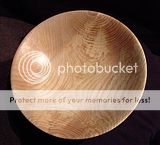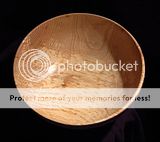johnny.t.
Established Member
Here are my latest efforts, both ash both around 8" wide.There is plenty of rot getting into this ash(don't know if you'd call it spalted, more a dry decay?) so theres lots of sanding where the soft bits get a lot of tear out. I thought I'd try 'feet' on them (I don't usually) , the foot works ok on the first but I really don't know how I came to leave the monster foot on the second 

 This is finished in my usual hard wax.
This is finished in my usual hard wax.


This one is done with sanding sealer(first time I've used it) and a soft paste wax, the finish is much better with sanding sealer, both in look and feel. Wish I'd always used it.
Let me know what you think
cheers JT

 This is finished in my usual hard wax.
This is finished in my usual hard wax.

This one is done with sanding sealer(first time I've used it) and a soft paste wax, the finish is much better with sanding sealer, both in look and feel. Wish I'd always used it.
Let me know what you think
cheers JT

































